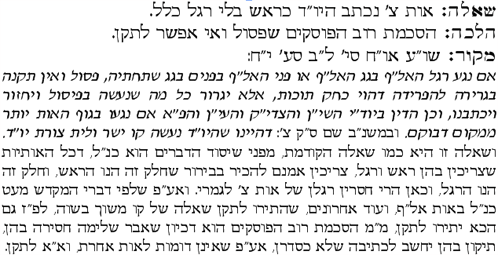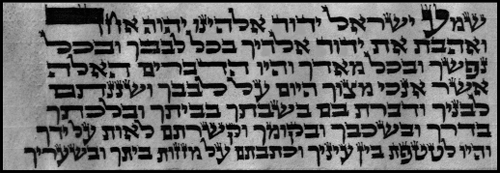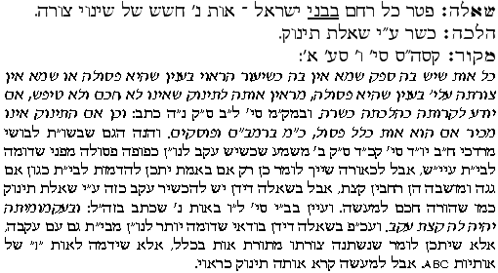

|
|
ArchivesFrom the eye of a Sofer; Sha’alos U’tshuvosHere we wish to show various Sha’alos which came up while Tefilin & Mezuzos were checked in the past few years. Many of the following Sha’alos are common for Sofrim to find. Again, this goes to show how many things can go wrong, and how someone examining Tefilin & Mezuzos must never let his guard down. 1
 This Mezuza probably became Posul through dampness, which caused some extra ink to became attached to a letter. This caused the letter to become unrecognizable. The ink can not be scratched away, causing the letter to be revealed properly. This would still be Posul since every letter must be created only through the specific act of writing, and not through scratching and erasing. A Sefer Torah or Megila would still be salvageable by erasing the entire letter and than rewriting it, because only Tefilin & Mezuzos must be written in order.  2
 The above Mezuza is a classical example of a common problem, which although it does not render the Mezuza Posul, it is still in the category of Bedieved, and should be corrected whenever possible. The tall part of the letter Lamed should be as tall as a Vav, not as short as a Yud as is in the Mezuza above.  3
 This Mezuza has many problems. But the most serious is the letter Vav. If you look closely at the Vav in the word Ve’al, and in the word Ukshartem, you will realize that in reality this is a Yud, not a Vav. Maybe a large Yud, but a Yud nevertheless. It is the letters next to it which are the same size, that give it the false impression of a Vav. Very often, it is these seemingly unimportant details, which render Tefilin & Mezuzos Posul. A Sofer must have a keen and critical eye to detect such technicalities.  4
 Here it would be nearly impossible for a layman to detect any problem. Once again, this should demonstrate the necessity of having Tefilin & Mezuzos checked by an experienced Sofer. Look closely at the Mem of the word Mitzvosai, and compare it to the other two Mem’s visible. The left part of the letter should clearly be a Vav comprised of a head and a foot. Here they are fused together as one without them being distinguishable.  5
 This Mezuza has a similar problem as the Mezuza shown previously. Look closely at all the Tzadik’s in this Mezuza. The right part should resemble a Yud facing right. While it should be comprised of a head with a small foot, here there is no foot to be found.  6
 This is undoubtfully the most common problem witnessed by Sofrim literally every day. Sooner or later even the most beautifully written Tefilin & Mezuzos will start having the effects of time - namely letters starting to crack. In the Mezuza above, the Tav in the word Veahavta, now resembles two different letters, due to some ink which came off - Posul beyond repair. However, in many instances, it could still be salvageable, depending on how and where the cracking is taking place.  7
 In the above shown Tefilin, the Sofer obviously noted the date on which he wrote them. Often, the Sofer forgets to erase these words, causing a serious problem. No extra words in any shape or form are allowed to exist on the parchment which contains the Parshiyos of Tefilin & Mezuzos. Special attention should be paid to erase any foreign letters or even markings from the surface of the parchment.  8
 Don’t be impressed by the “stamps of approval” affixed to these Mezuzos. These so called Hechsherim are not worth the paper their printed on. They have many serious problems, as explained below.      9
 Here the Sofer did not pay enough attention to the letter Lamed, which needs special awareness not to enter the territory of another letter, especially a Dalet. This renders the Dalet technically into a Hay.  10
 In this Mezuza, the Alef in the word Vavadtem, was probably connected to the Bais. The Sofer while trying to correct this problem, accidentally scratched off too much, turning it into a Chaf. This demonstrates how much care must be given while trying to correct problems, as not to create a bigger problem than existed originally. Here, the original problem of the two letters connected, could have been fixed, while the second problem the Sofer created with his good intentions, can not.  11
 The lines in Tefilin & Mezuzos should end evenly. The Sofer who wrote these Tefilin miscalculated and did not have enough room to finish the last two lines evenly. This created a problem, where the last three lines resemble a shape of steps which can render the Tefilin Posul.  12
 This Mezuza had attached to it the above “stamp of approval”, noting that it passed its inspection by a “certified Bodek”. Anyone can print such a note from his computer. It is clear that this Mezuza was not checked by anyone, let alone certified. Just one obvious example: Note the Lamed from the word Le’ahva touching the Ayin from the word Shamoa on the line above. Besides, the Lamed in itself does not have the proper shape; namely the tall part is missing its head. Many more problems were found with this Mezuza.  13
 Here is Parshas Shema of Tefilin Shel Rosh. The ink of the Tzadik in the word Metzavcha simply came off, and is no longer fixable. This can sometimes be caused by leaving Tefilin in a car where it can reach 150 degrees in the summer. This can cause the ink to run, causing serious damage.  14
 Similar problems to the above was already shown. As already explained, letters cracking over time is the problem Sofrim have to deal with the most. In the Mezuza above, the Nun in the word Beneichem, now resembles the letter Gimel due to some ink which came off - Posul beyond repair.  15
 The last line of this Mezuza was probably originally Posul. Someone, out of ignorance, cut off the last line, glued together another piece of parchment, and rewrote the last two words. Nothing has been gained by this idea, since a Mezuza must be written on one piece of parchment only.  16
 The second Mem of the word Yamima indeed looks like a Mem. Nevertheless, it is Posul beyond repair due to a drop of ink which closed its opening on the bottom, technically becoming a closed Mem which is of course only written at the end of a word. The ink can not simply be scratched away. This would still be Posul since every letter must be created only through the specific act of writing, and not through scratching and erasing. A Sefer Torah or Megilla would still be salvageable by erasing the entire letter and than rewriting it, but Tefilin & Mezuzos must be written in order.  17
 This is a mystery which has not been solved. Someone brought in his Tefilin to have them checked. It was then revealed that someone accidentally placed Parshiyos shel Rashi in his Bayis shel Yad of Rabeinu Tam! The top copy is written according to Rashi - first Shema, and than Vehoya Im Shamoa. The bottom copy is according to Rabeinu Tam - first Vehoya Im Shamoa, and than Shema. Who is responsible for this mix up? It is doutfull that we will ever know. But one thing is certain - that this unfortunate person had to buy new Rabeinu Tam Tefilin...  18
 Next to the Yud in the word Venasati, there is a hole in the parchment. It seems as if the Sofer did not examine the parchment well before he wrote on it. Close examination of the parchment before writing on it, is very important.  19
 Some ink came off the small left foot of the letter Hay from the word Eileh. It is now a bit too small. If a child can read it correctly, some ink can be added on to restore it to its proper size. See how such a seemingly unimportant tiny detail can invalidate Tefilin & Mezuzos.  20
 This is another example to show what a keen and critical eye a Bodek of Stam must have. The letter Yud of the word Vehoya is problematic. The Sofer wrote the left point a bit too long, transforming it into a small Ches. This is a typical example to show how careful a Sofer must be while forming the letters. The left point of the Yud must be protruding a bit - without it, the letter is Posul. Making this point a bit longer then required - creates the problem shown above. It must be just right.  21
 This Mezuza passed a computer inspection, and was indeed found to be free of any spelling mistakes. However, this by far does not guarantee the overall Kashrus of the Mezuza. The letter Alef in the word El is touching where it’s not supposed to. The Mezuza is therefore Posul.  22
 What do you do if you received a silver Mezuza holder for a gift, but unfortunatly, the size of the Mezuza is a bit too large ? No problem! Get a pair of scissors!... Remember - accommodate the Mezuza - not the holder!  23
 Looks can be deceiving. The Tav in the word Beveisecha might seem fine to most observers. However, in reality it is a Ches with its left foot merely widening at the bottom. Very often, it is these seemingly unimportant details, which render Tefilin & Mezuzos Posul. A Sofer must have a keen and critical eye to detect such technicalities.  24
 This is an interesting Shaala which is not so common. The foot of the letter Nun in the word Bivnei is not protruding from the extreme right side on the bottom. This might seem as resembling the letter ”I” of the alphabet. However, a child did read the letter correctly, and it was therefore permited to be fixed.  25
 What word do you see here? - Echad or is it Echa?  |







